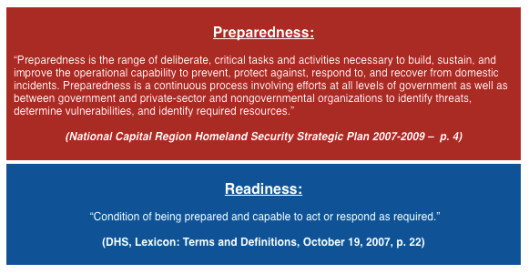Trying to define preparedness or readiness can be a frustrating task. It turns out that while there are many definitions, most skirt the task of actually providing a useful definition. For example, Webster’s dictionary defines preparedness as “the quality or state of being prepared” (prepared is defined as “subjected to a special process or treatment”). Poor definition leads to poor comprehension, which impedes our collective ability to improve preparedness.
In fact, when PricewaterhouseCoopers’ Health Research Institute (HRI) polled industry leaders in 2007 to define preparedness, “they agreed on only two things: (1) there is currently no universally accepted definition of preparedness; and (2) we must continue getting ‘better prepared.’”
The DHS Lexicon (2007) defined preparedness as “activities necessary to build, sustain, and improve readiness capabilities to prevent, protect against, respond to, and recover from natural or man-made incidents.” Note that this definition mentions readiness. There’s a lot of confusion regarding preparedness and readiness. In fact, the now defunct Homeland Security Presidential Directive (HSPD)-8, explains that “The term ‘preparedness’ refers to the existence of plans, procedures, policies, training, and equipment necessary at the Federal, State, and local level to maximize the ability to prevent, respond to, and recover from major events. The term ‘readiness’ is used interchangeably with preparedness.”
While the DHS Lexicon equates readiness with preparedness, I have a different perspective. In my opinion, preparedness is the sum of plans, policy, procedures, protocols, risk/hazard/threat/vulnerability identification/analysis, and development of training curriculum for incident response/recovery. In my opinion, readiness is somewhat different. Readiness is the capability of successfully responding or conducting recovery operations (in other words, the ability to implement processes, procedures, etc included in preparedness).
For example, police officers don’t have much preparedness on a normal patrol (a police car equipped with a shotgun and some flares) but police officers maintain a high degree of readiness (in the sense that they are able to respond quickly, understand how to order additional resources, and are generally well-trained). Developing the training is preparedness but ensuring that everyone is trained and able to execute their function is readiness.
While the differences between the two concepts might seem slight, both concepts are crucially important to ensuring a proper balance between theory and practice in maintaining successful and progressive emergency management programs.


